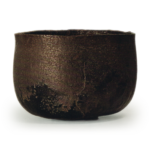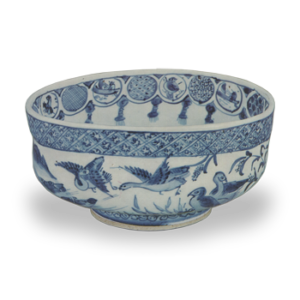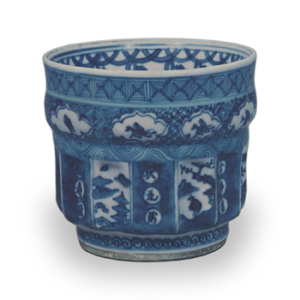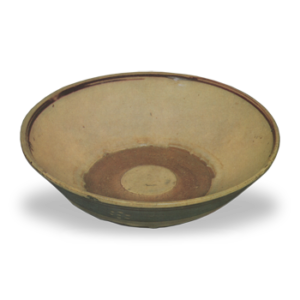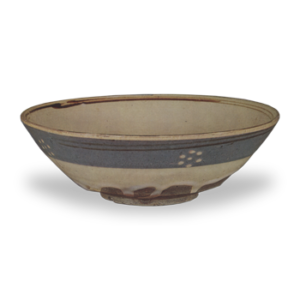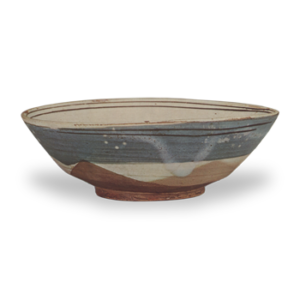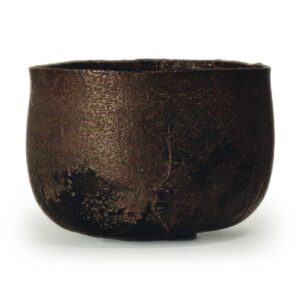
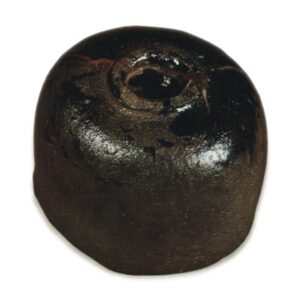
Height: 8.8cm
Diameter: 11.2-12.4cm
Foot diameter: 4.5-4.8cm
Height: 0.7cm
Koetsu’s pottery was the result of his refined sensibilities, so his style was truly free and not constrained by any formalities. Each piece was made as he wished, and this is the characteristic of his work. However, this teacup does not have the kind of air of nonchalance that Koetsu showed in his other teacups, and it has the feel of a teacup that Koetsu, in his later years, made in a state of non-attachment, simply by carving away at it.
The shape of the tea bowl is similar to that of an “rain cloud”, and the foot is so low that it looks like the bottom of a Go stone container at first glance. From the foot, it rises up in a slightly more linear fashion to the waist and mouth. There is also a slight bulge at the base, and it tapers slightly at the rim.
The rim of the mouth is cut horizontally, but the pattern is not as artificial as that of the “Rain Cloud” design.
The thickness of the rim is irregular, but it has an indescribable elegance.
The foot ring, which is carved in a circle, is not angular like the ones on “Fuji” or “Shichiri”, but is round and gentle, which is something you won’t find on other works. In the case of “Amagumo”, it is almost like the bottom of a Go-stone container.
The exterior glaze has almost completely scattered in the kiln, leaving only a small portion around the foot ring, giving it the appearance of an iron plate. However, the glaze around the foot ring is black and glossy. The interior is covered with black glaze for eight-tenths of the way up, but the rim shows the same texture as the exterior.
The inside of the bowl is wide, and it is particularly thin compared to other Koetsu tea bowls, giving the impression that it has been shaved down to the very last millimeter. Because it is thin, it is surprisingly light for its size.
Also, given the way the glaze has splattered, it is thought that the firing temperature was higher than one might expect. The large crack that runs from the foot to the body of the tea bowl, which is also known as the “Oyama crack”, is also thought to be the result of the extremely high firing temperature. There are also two other cracks that appear to be caused by the same phenomenon.
On the inside of the lid of the box, the two characters “Shigure” (meaning “light shower”) are written in gold powder. It is said that these characters were written by Prince Yoshihisa, the head priest of the Manjūin temple in Kyoto. It is thought that this inscription was written in reference to the tranquil appearance of the glaze on the tea bowl.
The outer box is made of paulownia wood and has a single-layered lacquer finish. On the front of the lid is the inscription “Famous Twelve Items: Tea Bowl, Kōetsu Work, Black, Shigure”, and on the back of the lid is the inscription “This tea bowl was in the Mitsui family collection, but in the Tenpō era, it was decided to give this tea bowl and the Kōetsu-style carved-nail tea bowl to the Hirase family. Iroha and the two pieces of Kibori-Iroha, which were in the Mitsui family collection, were to be given to the Hirase family, but they were sold to Toda Rokin at this auction, and I, who am not worthy of such a sum, have repeatedly begged for it and made it a treasure of Saigyoan. Shigure” is written in the handwriting of Prince Yoshihisa, and the seal is that of Kanemitsu Nakatsuka. The writer is Shimomura, a tea master of the Hisada school from Owari-Ota, and his tearoom was called Saigyoan. He died in 1916 at the age of 80.
The history of the tea bowl is not clear, but it later became the property of the Mitsui family, and then the Hirose family. In 1903, when the Hirose family put it up for sale, it came into the possession of Toda Rogen, and then, at the request of Shimomura Saigyoan, it became his prized possession.

